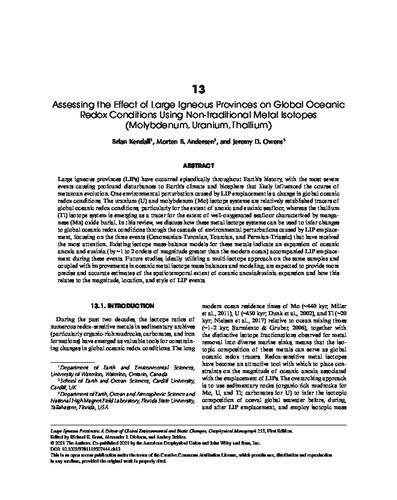| dc.contributor.author | Kendall, Brian | |
| dc.contributor.author | Andersen, Morten B. | |
| dc.contributor.author | Owens, Jeremy | |
| dc.date.accessioned | 2023-10-27 14:47:30 (GMT) | |
| dc.date.available | 2023-10-27 14:47:30 (GMT) | |
| dc.date.issued | 2021-01-08 | |
| dc.identifier.uri | https://doi.org/10.1002/9781119507444.ch13 | |
| dc.identifier.uri | http://hdl.handle.net/10012/20069 | |
| dc.description | This book chapter is made openly available through a Creative Commons Attribution 4.0 International license https://creativecommons.org/licenses/by/4.0/. | en |
| dc.description.abstract | Large igneous provinces (LIPs) have occurred episodically throughout Earth’s history, with the most severe events causing profound disturbances to Earth’s climate and biosphere that likely influenced the course of metazoan evolution. One environmental perturbation caused by LIP emplacement is a change in global oceanic redox conditions. The uranium (U) and molybdenum (Mo) isotope systems are relatively established tracers of global oceanic redox conditions, particularly for the extent of anoxic and euxinic seafloor, whereas the thallium (Tl) isotope system is emerging as a tracer for the extent of well‐oxygenated seafloor characterized by manganese (Mn) oxide burial. In this review, we discuss how these metal isotope systems can be used to infer changes to global oceanic redox conditions through the cascade of environmental perturbations caused by LIP emplacement, focusing on the three events (Cenomanian‐Turonian, Toarcian, and Permian‐Triassic) that have received
the most attention. Existing isotope mass‐balance models for these metals indicate an expansion of oceanic anoxia and euxinia (by ~1 to 2 orders of magnitude greater than the modern ocean) accompanied LIP emplacement during these events. Future studies, ideally utilizing a multi‐isotope approach on the same samples and coupled with improvements in oceanic metal isotope mass balances and modeling, are expected to provide more precise and accurate estimates of the spatiotemporal extent of oceanic anoxia/euxinia expansion and how this relates to the magnitude, location, and style of LIP events. | en |
| dc.language.iso | en | en |
| dc.publisher | American Geophysical Union and John Wiley and Sons, Inc. | en |
| dc.relation.ispartofseries | Geophysical Monograph Series; | |
| dc.title | Assessing the Effect of Large Igneous Provinces on Global Oceanic Redox Conditions Using Non-traditional Metal Isotopes (Molybdenum, Uranium, Thallium) | en |
| dc.type | Book Chapter | en |
| dcterms.bibliographicCitation | Kendall B., Andersen M.B., Owens J.D. (2021). Assessing the effect of large igneous provinces on global oceanic redox conditions using non-traditional metal isotopes (molybdenum, uranium, thallium). In R.E. Ernst, A.J. Dickson, A. Bekker (Eds.), Large Igneous Provinces: A Driver of Global Environmental and Biotic Changes, AGU Geophysical Monograph 255, pp. 299-317. | en |
| uws.contributor.affiliation1 | Faculty of Science | en |
| uws.contributor.affiliation2 | Earth and Environmental Sciences | en |
| uws.typeOfResource | Text | en |
| uws.peerReviewStatus | Reviewed | en |
| uws.scholarLevel | Faculty | en |

